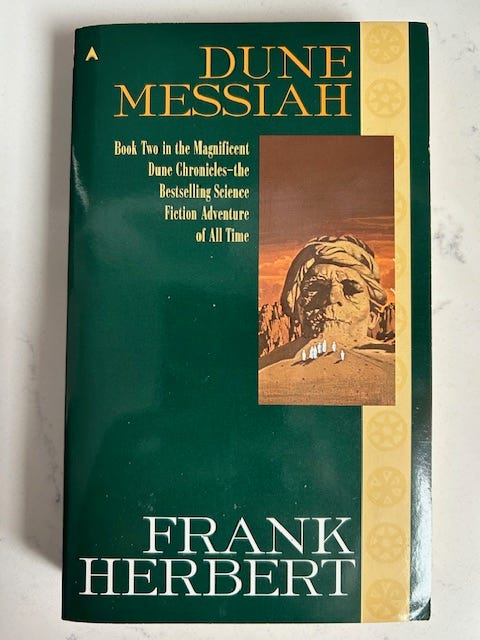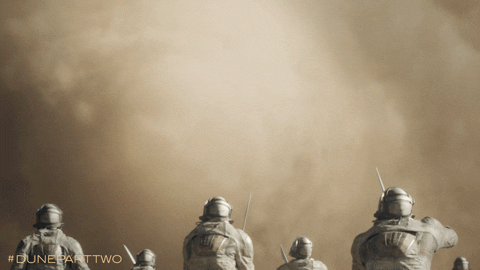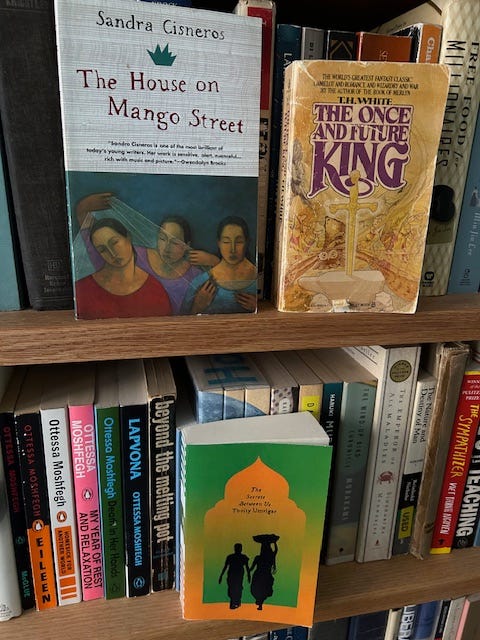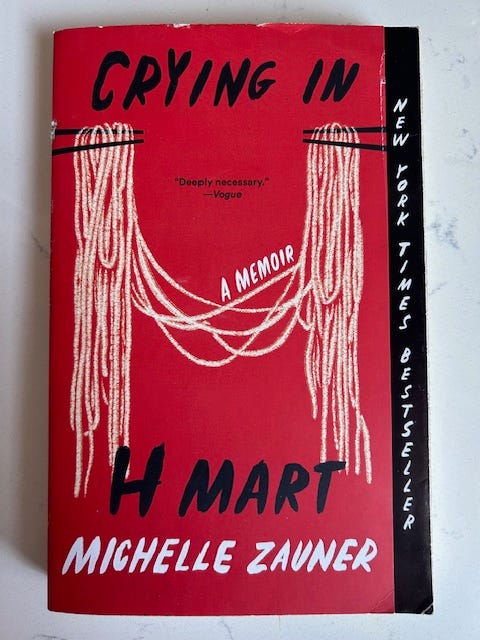
After the revolution come the meetings. (Alert: Minor spoilers ahead if you haven’t read ‘Dune’ or seen ‘Dune: Part Two’ yet.) For Paul Atreides, a decade-plus after he becomes emperor of the galaxy and a messianic figure, there are so many meetings! His throne room on the planet Arrakis is teeming with people wanting to talk about the ongoing holy war being waged in his name across the known universe and other matters of state. In quiet moments, he’s having a tête-à-tête with his lover, Chani, about whether he will produce an heir with her or his legal wife, Irulan, who’s the daughter of the former emperor. Other times, he’s comparing notes with his teenage sister, Alia, who has magical powers and superior fighting abilities. Seriously, at times it feels like Oprah is handing out meetings to everyone:

This is what happens when you live in a society that long ago banned all computers, AI and thinking machines. A meeting that could have been an email can only be an in-person meeting. As you’ll see below, the book even opens mid-meeting.
Here’s the cover:

And then there are the meetings among conspirators plotting against Paul. They include a reverend mother of the Bene Gesserit (a coven of witches who manipulate politics and power from the shadows through plots and religious narratives), a Guild steersman (from the group who conduct space travel through use of a powerful drug called Spice that’s found only on Arrakis), a person called a Face Dancer (who can contort the muscles of their body to assume the shapes of other people), and members of the Fremen (the indigenous people of Arrakis who fueled Paul’s rise to power). The conspirators also have reanimated the corpse of a friend and mentor to Paul to plant at his court to get close to the young emperor and undermine him. They have a variety of grievances, from being unable to control Paul, to Paul’s bringing water to Arrakis (a challenge to Fremen traditions). Their scheme has two aims: 1) to overthrow Paul, and 2) to break Paul’s complete control over Spice by stealing the creature that produces it, a giant sandworm from Arrakis:

Paul, meanwhile, is weary and introspective. In a meeting with an aide, he discusses scraps of Earth’s history retained from many millennia in his past and compares the death count of his religious war (tens of billions) to those of past conquerors like Genghis Khan and Hitler. I wrote in my review of ‘Dune’ that author Frank Herbert seemed skeptical of heroes and the power they had in public consciousness. These comparisons hammer the point—Paul is not a traditional ‘hero’ in this story. In my earlier review, I compared Paul to Luke Skywalker, since ‘Dune’ heavily influenced ‘Star Wars,’ but this was wrong. Paul is closer to Anakin Skywalker, a ‘chosen one’ falling to the dark side. I mean, look at the costume design for Paul in “Dune: Part Two” (I saw it last night; it’s good, but long):

Paul is also plagued by visions of the future. He knows there’s a plot against him, and he knows tragedy awaits. What should he do? How can he protect those he loves and escape peril? He wonders if he should be allowed to escape, or be forced to account for all the death and destruction he’s inspired. He knows:
Paul’s choice not only seals his fate, but also that of those close to him, particularly Chani and Alia, and sets the course for future ‘Dune’ sequels. I won’t give any of it away, but I want to ask you whether you want me to continue reviewing this series. Vote here:
If you’ve had enough of ‘Dune,’ let me know in the comments what you’d like to see instead. For sci-fi/fantasy, on hand, I’ve got the first books in the ‘Foundation,’ ‘Thrawn’ and ‘Wheel of Time’ series.
The universe of ‘Dune’ is fascinating and relevant to today’s political issues. Not only does it explore the pitfalls of hero worship and political power, but it’s also concerned with the environment and control of natural resources. While this book wasn’t as action-packed as the first, I enjoyed reading it. If you’re planning to see the movies (‘Dune Messiah’ is being adapted for a future installment, I believe), you should also check out this book.
How it begins:
Excerpts from the Death Cell Interview with Bronso of Ix—
Q: What led you to take your particular approach to a history of Muad’dib?
A: Why should I answer your questions?
Q: Because I will preserve your words.
A: Ahhh! The ultimate appeal to a historian!
Q: Will you cooperate then?
A: Why not? But you’ll never understand what inspired my Analysis of History. Never. You Priests have too much at stake to …
Q: Try me.
A: Try you? Well, Again … why not? I was caught by the shallowness of the common view of this planet which arises from its popular name: Dune. Not Arrakis, notice, but Dune. History is obsessed by Dune as desert, as birthplace of the Fremen. Such history concentrates on the customs which grew out of water scarcity and the fact that Fremen led semi-nomadic lives in stillsuits which recovered most of their body’s moisture.
Q: Are these things not true, then?
A: They are surface truth. As well ignore what lies beneath that surface as … as try to understand my birthplanet, Ix, without exploring how we derived our name from the fact that we are the ninth planet of our sun. No … no. It is not enough to see Dune as a place of savage storms. It is not enough to talk about the threat posed by the gigantic sandworms.
My rating:

‘Dune Messiah’ by Frank Herbert originally was published, in a shorter version, by Galaxy magazine in 1969. It was published by The Berkeley Publishing Group in 1975 and by Ace Books in 1987. 331 pages. $9.29 at Bookshop.org.
Recent pickups:
‘The House on Mango Street’ by Sandra Cisneros (Park Slope United Methodist Church book sale)
‘The Once and Future King’ by T.H. White (Park Slope United Methodist Church book sale)
‘The Secrets Between Us’ by Thirty Umrigar (Barnes & Noble)
Books on GIF does not solicit review copies. We feature books we purchase at independent bookstores around New York City and on our travels, or were borrowed electronically from the Brooklyn Public Library.
What’s next:
Before you go:
ICYMI: Review #226
Read this: The latest issue of Bugstack, my favorite newsletter about Earth-born bugs, explores the biology and the importance of the massive sandworms of Arrakis. This is a true statement that underlines the enduring resonance of the ‘Dune’ books: ‘[Author Frank] Herbert steeped his books in a lot of the contemporary concerns of his day (many of which remain the concerns of our day), and one of those was environmentalism, the different forms it takes, the different questions it engenders.’
Do this: Katya Apekina discusses her forthcoming second novel ‘Mother Doll’ with Rachel Lyon at McNally Jackson SoHo on March 19. Here are the details. Donna and I are excited to attend the event!
If you enjoyed this review:
Thanks for reading, and thanks especially to Donna for editing this newsletter!
Until next time,
MPV











Have you read the first one!? If so, I’d love to read your review. I’m considering it….
I’m so glad you reviewed this book because now I know, the Dune series is not my jam. I enjoyed reading your thoughts as always but could barely get through the excerpt from the book at the end lol. Excited to hear what you think of Crying in H-Mart!